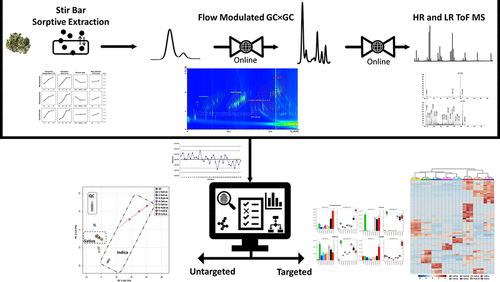当前位置:
X-MOL 学术
›
Anal. Chem.
›
论文详情
Our official English website, www.x-mol.net, welcomes your
feedback! (Note: you will need to create a separate account there.)
In-Depth Cannabis Multiclass Metabolite Profiling Using Sorptive Extraction and Multidimensional Gas Chromatography with Low- and High-Resolution Mass Spectrometry.
Analytical Chemistry ( IF 6.7 ) Pub Date : 2020-06-30 , DOI: 10.1021/acs.analchem.0c01301 Flavio A Franchina 1 , Lena M Dubois 1 , Jean-François Focant 1
Analytical Chemistry ( IF 6.7 ) Pub Date : 2020-06-30 , DOI: 10.1021/acs.analchem.0c01301 Flavio A Franchina 1 , Lena M Dubois 1 , Jean-François Focant 1
Affiliation

|
The present research reports on the development of a methodology to unravel the complex phytochemistry of cannabis. Specifically, cannabis inflorescences were considered and stir bar sorptive extraction (SBSE) was used for the preconcentration of the metabolites. Analytes were thermally desorbed into a comprehensive two-dimensional (2D) gas chromatography (GC × GC) system coupled with low- and high-resolution mass spectrometry (MS). Particular attention was devoted to the optimization of the extraction conditions, to extend the analytes’ coverage, and the chromatographic separation, to obtain a robust data set for further untargeted analysis. Monoterpenes, sesquiterpenes, hydrocarbons, cannabinoids, other terpenoids, and fatty acids were considered to optimize the extraction conditions. The response of selected ions for each chemical class, delimited in specific 2D chromatographic regions, enabled an accurate and fast evaluation of the extraction variables (i.e., time, temperature, solvent, salt addition), which were then selected to have a wide analyte selection and good reproducibility. Under optimized SBSE conditions, eight different cannabis inflorescences and a quality control sample were analyzed and processed following an untargeted and unsupervised approach. Principal component analysis on all detected metabolites revealed chemical differences among the sample types which could be associated with the plant subspecies. With the same SBSE–GC × GC–MS methodology, a quantitative targeted analysis was performed on three common cannabinoids, namely, Δ9-tetrahydrocannabinol, cannabidiol, and cannabinol. The method was validated, giving correlation factors over 0.98 and <20% reproducibility (relative standard deviation). The high-resolution MS acquisition allowed for high-confidence identification and post-targeted analysis, confirming the presence of two pesticides, a plasticizer, and a cannabidiol degradation product in some of the samples.
中文翻译:

使用吸附萃取和多维气相色谱与低分辨率和高分辨率质谱进行深度大麻多类代谢物分析
本研究报告介绍了解开大麻复杂植物化学方法的方法。具体而言,考虑了大麻花序,并使用搅拌棒吸附萃取(SBSE)进行代谢物的预浓缩。将分析物热解吸到全面的二维(2D)气相色谱(GC×GC)系统中,并与低分辨率和高分辨率质谱(MS)结合使用。特别注意优化提取条件,以扩大分析物的覆盖范围和色谱分离,以获得用于进一步非目标分析的可靠数据集。认为单萜,倍半萜,碳氢化合物,大麻素,其他萜类和脂肪酸可优化提取条件。所选离子对每种化学类别的响应,在特定的2D色谱区域中进行定界,可以准确,快速地评估提取变量(即时间,温度,溶剂,盐的添加),然后选择这些提取变量以具有广泛的分析物选择和良好的重现性。在优化的SBSE条件下,按照无目标,无监督的方法分析和处理了八种不同的大麻花序和质量控制样品。对所有检测到的代谢物的主成分分析表明,样品类型之间的化学差异可能与植物亚种有关。使用相同的SBSE–GC×GC–MS方法,对三种常见的大麻素(即Δ9-四氢大麻酚,大麻二酚和大麻酚)进行了定量靶向分析。方法经过验证,相关系数超过0.98且< 重现性20%(相对标准偏差)。高分辨率的MS采集可进行高可信度鉴定和后目标分析,从而确定了某些样品中两种农药,增塑剂和大麻二酚降解产物的存在。
更新日期:2020-08-04
中文翻译:

使用吸附萃取和多维气相色谱与低分辨率和高分辨率质谱进行深度大麻多类代谢物分析
本研究报告介绍了解开大麻复杂植物化学方法的方法。具体而言,考虑了大麻花序,并使用搅拌棒吸附萃取(SBSE)进行代谢物的预浓缩。将分析物热解吸到全面的二维(2D)气相色谱(GC×GC)系统中,并与低分辨率和高分辨率质谱(MS)结合使用。特别注意优化提取条件,以扩大分析物的覆盖范围和色谱分离,以获得用于进一步非目标分析的可靠数据集。认为单萜,倍半萜,碳氢化合物,大麻素,其他萜类和脂肪酸可优化提取条件。所选离子对每种化学类别的响应,在特定的2D色谱区域中进行定界,可以准确,快速地评估提取变量(即时间,温度,溶剂,盐的添加),然后选择这些提取变量以具有广泛的分析物选择和良好的重现性。在优化的SBSE条件下,按照无目标,无监督的方法分析和处理了八种不同的大麻花序和质量控制样品。对所有检测到的代谢物的主成分分析表明,样品类型之间的化学差异可能与植物亚种有关。使用相同的SBSE–GC×GC–MS方法,对三种常见的大麻素(即Δ9-四氢大麻酚,大麻二酚和大麻酚)进行了定量靶向分析。方法经过验证,相关系数超过0.98且< 重现性20%(相对标准偏差)。高分辨率的MS采集可进行高可信度鉴定和后目标分析,从而确定了某些样品中两种农药,增塑剂和大麻二酚降解产物的存在。











































 京公网安备 11010802027423号
京公网安备 11010802027423号